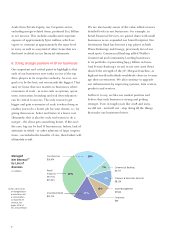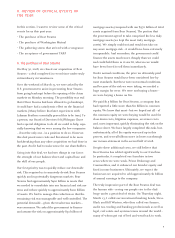JP Morgan Chase 2008 Annual Report Download - page 20
Download and view the complete annual report
Please find page 20 of the 2008 JP Morgan Chase annual report below. You can navigate through the pages in the report by either clicking on the pages listed below, or by using the keyword search tool below to find specific information within the annual report.18
Too many regulators – with overlapping responsibilities
and inadequate authorities – were ill-equipped to handle
the crisis
Our current regulatory system is poorly organized and
archaic. Overlapping responsibilities have led to a dif-
fusion of responsibility and an unproductive competi-
tion among regulators, which probably accelerated a
race to the bottom. Many regulators also did not have
the appropriate statutory authority (through no fault
of their own) to deal with some of the problems they
were about to face. One large, glaring example revealed
by the collapse of Bear Stearns and Lehman was the
lack of a resolution process in place to deal with failure
of investment banks. If commercial banks fail, the
FDIC can take them over. This was not the case with
investment banks. In addition, a resolution process
needs to be in place for large, global financial compa-
nies that operate in many jurisdictions and use many
different regulatory licenses.
E. The pro-cyclical nature of virtually all policies,
actions and events
In a crisis, pro-cyclical policies make things worse. I
cannot think of one single policy that acted as a coun-
terbalance to all of the pro-cyclical forces. Although
regulation can go only so far in minimizing the impact
of pro-cyclical forces in times of crisis, we still must be
aware of the impact they have. For example:
• Loan loss reserving causes reserves to be at their
lowest level right when things take a turn for the
worse. Therefore, as a crisis unfolds, a bank not only
faces higher charge-offs but also has to add to its
level of reserves, depleting precious capital.
• Although we are proponents of fair value accounting
in trading books (a lot of the mark-to-market losses
that people complained about will end up being real
losses), we also recognize that market levels resulting
from large levels of forced liquidations may not
reflect underlying values. Certain applications of
fair value accounting can contribute to a downward
spiral where losses deplete capital, and lower capital
causes people to respond by selling more, at increas-
ingly lower values.
• The rating agencies made mistakes (like the rest of
us) that clearly helped fuel a CDO and mortgage
debacle. They also, in the midst of a crisis, continual-
ly downgraded credits. Lower ratings, in turn,
required many financial institutions to raise more
capital, thus adding to the vicious cycle.
• In bad times, the market itself demands both an
increase in capital and more conservative lending.
We may not be able to change this phenomenon,
but there are steps we can take to ensure that the
system is better prepared for it.
• Financing arrangements allow the most leverage in
good times, but they force a dramatic reduction in
leverage in bad times.
• As capital markets volatility increases, Basel II
capital calculations and many risk management
tools, like Value-at-Risk, demand that more capital
be held to own securities or loans.
F. The impact of huge trade and financing imbalances
on interest rates, consumption and speculation
I suspect when analysts and economists study the
fundamental causes of this crisis, they will point to the
enormous U.S. trade deficit as one of the main under-
lying culprits. Over an eight-year period, the United
States ran a trade deficit of $3 trillion. This means that
Americans bought $3 trillion more than they sold over-
seas. Dollars were used to pay for the goods. Foreign
countries took these dollars and purchased, for the
most part, U.S. Treasuries and mortgage-backed securi-
























